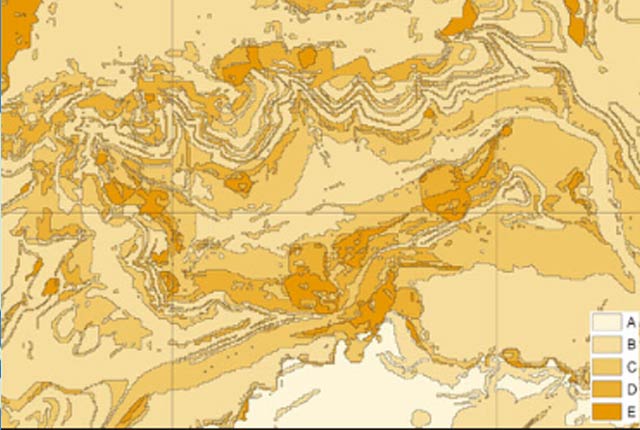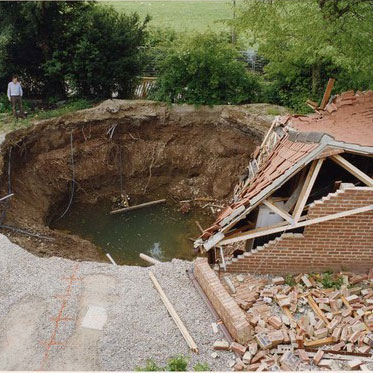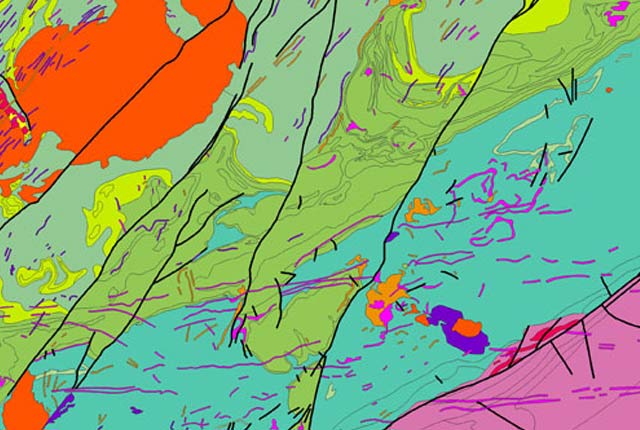If dissolution-related subsidence appears to be happening on or near your property, inform your insurance company, mortgage lender or landlord. Get specialist advice from a suitably qualified expert such as a structural surveyor, geotechnical engineer or chartered engineering geologist.
If active dissolution is not happening but the area has potential for dissolution this should be taken into account before starting new buildings or changes in land use.
- Maintain drains, water mains, swimming pools and ponds to ensure they do not leak.
- Ensure building foundations are designed to span likely cavities.
- Determine the nature of rockhead before construction.
- Do not dispose of surface water to soakaways.
- Do not create concentrations of surface water draining from hardstanding, roads or paths that may infiltrate the ground at a single point.
- Do not lower the water level in the ground, change the ground water flow or the surface water flow without considering the consequences for dissolution hazards.
Hazard ratings and advice
| Hazard rating | Advice for public | Advice for specialist |
|---|---|---|
| A — soluble rocks are either not thought to be present, or are not prone to dissolution. Dissolution features are unlikely to be present. | No actions required to avoid problems due to soluble rocks. | No special ground investigation required or increased construction costs or increased financial risk due to potential problems with soluble rocks. |
| B — soluble rocks are present but unlikely to cause problems except under exceptional conditions. | No actions required to avoid problems due to soluble rocks. | No special ground investigation required or increased construction costs. An increase in financial risk due to problems with soluble rocks is unlikely. |
| C — significant soluble rocks are present. Low possibility of localised subsidence or dissolution related-degradation of bedrock occurring naturally, but may be possible in adverse conditions such as high surface or subsurface water flow. | Consider implications for stability when changes to surface drainage or new construction are planned. Do not dispose of surface drainage to the adjacent ground. | New build — site investigation should consider potential for dissolution problems on the site and its surroundings. Care should be taken with local drainage into the adjacent bedrock.
Existing property— possible increase in insurance risk due to soluble rocks. Some possibility of potential liability due to groundwater pollution may be present. |
| D — very significant soluble rocks are present with a moderate possibility of localised natural subsidence or dissolution-related degradation of bedrock, especially in adverse conditions such as concentrated surface or subsurface water flow. | Consider obtaining specialist advice before loading the land or undertaking building work. Do not dispose of surface drainage to the adjacent ground. Maintain drainage infrastructure. | New build — specialist site investigation and stability assessment may be necessary before construction. Construction work may cause subsidence. Isolate surface drainage from the karst system and groundwater. Increased construction costs are possible.
Existing property— possible increase in insurance risk due to soluble rocks. Some possibility of potential liability due to groundwater pollution may be present. |
| E — very significant soluble rocks are present with a high possibility of localised subsidence or dissolution-related degradation of bedrock occurring naturally, especially in adverse conditions such as concentrated surface or subsurface water flow. | Obtain specialist advice to advise on need for stabilisation work and/or land management plan to maintain stability. Do not dispose of surface drainage into the adjacent ground. Maintain drainage infrastructure. | New build — specialist land stability assessment necessary. Investigation, remediation and/or mitigation works may be necessary to stabilise the area. Construction work may cause subsidence. Isolate surface drainage from the karst system and groundwater. Increased construction costs.
Existing property — probable increase in insurance risk due to soluble rocks. Probable potential liability due to groundwater pollution. |
You may also be interested in

BGS GeoSure
The BGS GeoSure datasets identify areas of potential hazard and, therefore, potential natural ground movement, in Great Britain.

BGS GeoSure: soluble rocks
Ground dissolution occurs when water passing through soluble rocks produces underground cavities and cave systems. These cavities reduce support to the ground above and can cause localised collapse of the overlying rocks and deposits.


